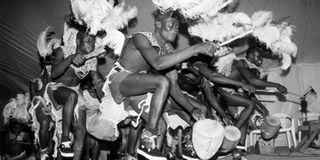The abolition of kingdoms in Uganda

Acholi Bwola dancers exhibit their skills. Dance , as one of Uganda’s cultural identities, has also evolved over the years. PHOTO COURTESY OF PRESIDENTIAL INITIATIVE
What you need to know:
Uganda is known for the cultural diversity and unity of its people under esteemed traditional leaders. However, the progress of kingdoms as well as threats to their existence, becomes visible every day.
Kampala
Buganda was, arguably one of the most culturally cohesive and strongest kingdoms prior to the arrival of and colonisation of Uganda by the British. Social neatness and political structures were piloted and kept intact by a Kabaka—loyally revered by subjects.
Therefore, when by the 1960, the kingdom of Buganda progressed to the level of braving a political coalition that would see it become part of a national government, a lot of prizes and pains were expected to be reaped. As earlier stated, Buganda, had hastily formed the KY party, which together with the Obote-led UPC party, steered the country to independence under a coalition.
Buganda’s autonomy
One of the key reasons for that alliance and the formation of KY, was the advancement of Buganda Kingdom interests, particularly, it being an autonomous state within Uganda. However, by entering a coalition government, with Kabaka Muteesa as president, an unseen message had been sent--that the kingdom interests would have to be diversified to include the greater Uganda.
When that did not happen, Buganda’s secessionist inclinations and Obote’s unity call after independence, would become the point of strife and final untying of the UPC/KY alliance. In our last article, we indicated that events surrounding the 1966 Mengo Crisis, had included the suspension and abrogation of the Independence Constitution.
Prime Minister Apollo Milton Obote, had on April 15, 1966, caused the ‘formal’ adoption of a ‘pigeon hole’ law. He had, during a ceremony, described by Prof. Tarsis B. Kabwegyere as ‘hushed’ and without debate, declared; “…it is hereby resolved that the constitution that came into being on the 9th day of October 1962 be abolished and it is hereby abolished accordingly and the constitution now before us to be adopted and it hereby adopted this day, 15th April 1966.”
The ‘republican’ Constituion
The ‘pigeon hole’ constitution, clipped the powers of the president and bestowed executive powers on the Prime Minister. The greatest slap to Buganda and the rest of the monarchies in Uganda, would, however be the adoption of the 1967 ‘republican constitution’ that ultimately eliminated kingdoms.
Article 118(1) of the new law, stated thus: “The institution of King or Ruler of a Kingdom or Constitutional Head of a District, by whatever name called, existing immediately before the commencement of this Constitution under the law then in force, is hereby abolished.”
With that declaration and Buganda’s king exiled to Britain, open anger towards the Milton Obote government was exhibited. Historian Phares Mutibwa, who, avidly defends Buganda in his book Uganda Since Independence; argues that kingdoms are a symbol of culture and tradition and its desecration justified the animosity towards Obote.
“Up to this day, the Baganda and the people of the other kingdom areas have never forgiven Obote (this does not apply to Amin, who they knew, acted only as Obote’s instrument) for the destruction and abolition of their kingdoms which had existed for some five centuries,” argues Mutibwa.
As earlier seen, Uganda was by 1966, in a period of embryonic, albeit heated political contest, where the players; Obote and Muteesa, were unwilling to relent in their pursuit of comforts. At the end of the day, the contender with the greatest power and wit, took the day.
The concentration of power tussling between Buganda and central government, kind of overshadowed the impact of the abolition of other kingdoms in Uganda. That is, however, not to suggest that the rest of the kingdoms were less ‘mighty’.
Bunyoro for instance, boasted of a fierce and organised army, notably under Omukama Kabalega and posed a military nuisance to the British and its soldiers. “In the history of Uganda, it is Bunyoro that presented collective armed combat against foreign intervention. Until Omukama (king) Kabalega fell in 1899, Bunyoro was a scene of pitched battles for many years,” explains Prof. Kabwegyere. The advent of colonial rule had destroyed the body of Bunyoro but the kingdom remained alive in the hearts and souls of its people.
Meanwhile, Toro, earlier been part of Bunyoro, prided in its economic might, notably the salt Lake Katwe that was, from the start, a key resource of contention between the British and Belgians. Ankole, like Toro, was created, argues Prof. Kabwegyere, during the process of territorial consolidation that came with British colonisation. And yet, even then, the kingdom boasted of a monarch and a fertile economy.
Even in the more decentralised areas, such as in northern Uganda, the traditional institutions carried cultural, economic, and political value. For instance, among the Acholi of northern Uganda, clan heads ensured military and economic might of their people and also co-existed with other clans.
The people of Uganda had for centuries been organised in these tribe-based institutions. Tribes had fought, inter-married, built alliances, broken alliances. The call of the tribe was powerful. It was a source of identity and offered security.
Forced nation-building
This blanket of security, this sense of self, was swept away overnight, history brushed aside by the stoke of the pen and the passing of a new, undebated law. The people who formerly belonged to those power structures had been herded into a container called Uganda, their identity changed overnight to ‘Ugandans’. It was nation-building by force, not negotiation, and the fallacy of such a union would return to haunt the country and its people over the next 50 years.



